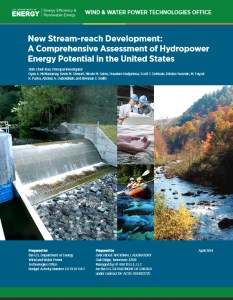
by Brianna Crandall — May 7, 2014—Building on the Obama Administration’s commitment to an all-of-the-above energy strategy, the U.S. Department of Energy (DOE) and its Oak Ridge National Laboratory (ORNL) released a renewable energy resource assessment on April 29 detailing the potential to develop new electric power generation in waterways across the United States.
The report estimates over 65 gigawatts (GW) of potential new hydropower development across more than three million U.S. rivers and streams—nearly equivalent to the current U.S. hydropower capacity. These findings demonstrate one of the ways the United States can further diversify its energy portfolio with sustainable and clean domestic power generation. The Energy Department is working with industry, universities, and state and local governments to advance innovative hydropower technologies.
According to DOE, hydropower makes up seven percent of total U.S. electricity generation, and continues to be the United States’ largest source of renewable electricity, avoiding over 200 million metric tons of carbon emissions each year. Hydropower also provides reliable baseload power day and night—providing greater flexibility and diversity to the electric grid and allowing utilities to integrate other renewable sources such as wind and solar power.
The New Stream-reach Development assessment just released capitalizes on recent advancements in geospatial datasets, and reportedly represents the most detailed evaluation of U.S. hydropower potential at undeveloped streams and rivers to date. The greatest hydropower potential was found in western U.S. states, including Alaska, California, Colorado, Idaho, Montana, Oregon and Washington. Kansas, Missouri, Pennsylvania and Wyoming lead the rest of the country in new stream-reach hydropower potential.
The hydropower resource assessment also analyzed technical, socioeconomic and environmental characteristics that will help energy developers, policymakers and local communities identify the most promising locations for sustainable hydropower facilities. The assessment includes stream- and river-specific information on local wildlife habitats, protected lands, water use and quality, and fishing access areas.
New Stream-reach Development: A Comprehensive Assessment of Hydropower Energy Potential in the United States builds on a 2012 Energy Department assessment that found over 12 GW of hydropower potential at the nation’s existing 80,000 non-powered dams. The results of the resource assessment just released show that there are still many opportunities to develop new hydropower projects around the country, most of which would likely be smaller, run-of-river facilities that could utilize new low-impact designs and technologies.
DOE’s New Stream-reach Development Resource Assessment Web page offers the full stream-reach resource assessment as well as additional maps and data on new hydropower potential.





